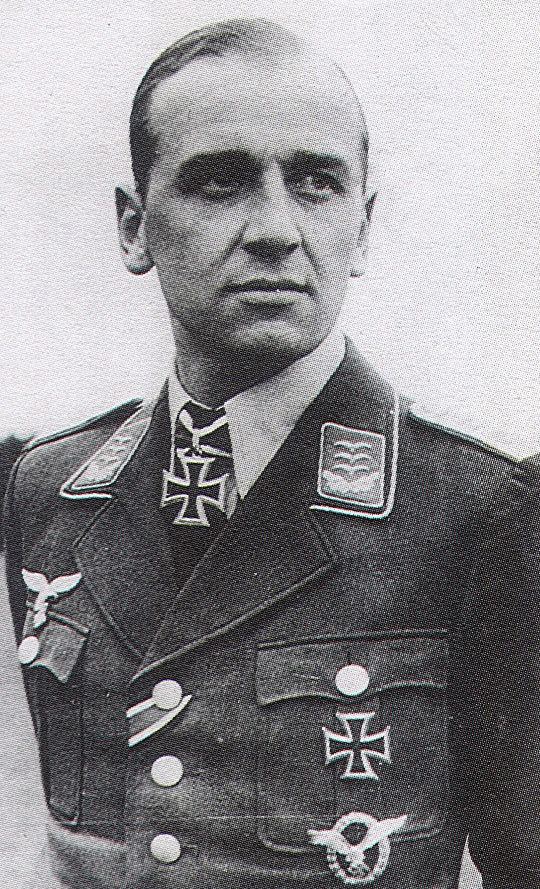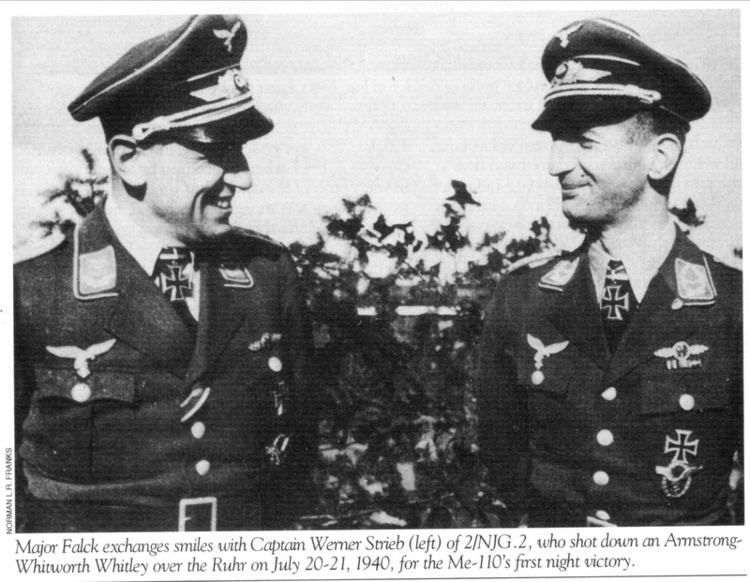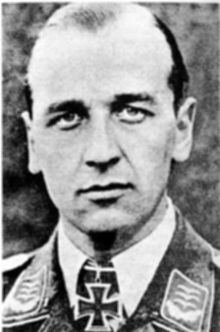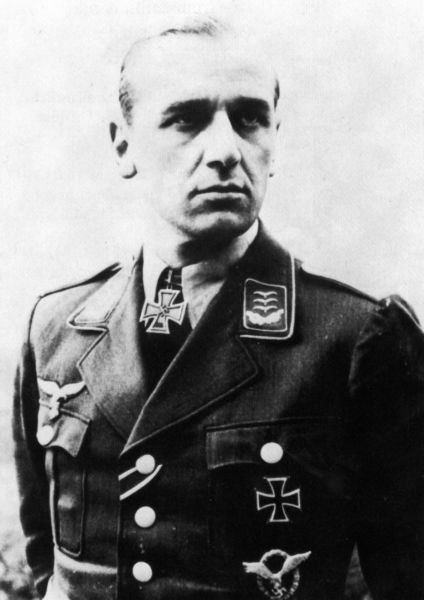Years of service 1934–451956–66 | Name Werner Streib Rank OberstBrigadegeneral | |
 | ||
Born 13 June 1911Pforzheim ( 1911-06-13 ) Buried at Munchen, OstfriedhofPlot 41—Row 1—Grave 5 Battles/wars World War IIInvasion of Poland (1939)Defense of the Reich Service/branch German Army (1934–1935), Luftwaffe (1935–1945), German Air Force (1956–1966) | ||
Heinkel HE 219 uhu (Eagle-Owl) & Ta 154 "mosquito"
Werner Streib (13 June 1911 – 15 June 1986) was a German Luftwaffe military aviator during World War II, a night fighter ace credited with 68—one daytime and 67 nighttime—enemy aircraft shot down in about 150 combat missions. All of his nocturnal victories were claimed over the Western Front in Defense of the Reich missions against the Royal Air Force's Bomber Command.
Contents
- Heinkel HE 219 uhu Eagle Owl Ta 154 mosquito
- Early life
- World War II
- Night fighter career
- Kammhuber Line
- Testing the Heinkel He 219
- High command
- Later life
- Aerial victory claims
- Awards
- References

Born in Pforzheim, Streib grew up in the Weimar Republic and Third Reich. Following graduation from school, he began military service in the Reichswehr in 1934 and in 1936, transferred to the Luftwaffe. After training at various postings, he served with Zerstörergeschwader 1 (ZG 1—1st Destroyer Wing) flying a Messerschmitt Bf-110 heavy fighter at the outbreak of World War II. On 10 May 1940, Streib claimed his first aerial victory. In June 1940, he was appointed Staffelkapitän (squadron leader) of the 2. Staffel (2nd squadron) of ZG 1. Shortly later, this squadron became 2. Staffel of Nachtjagdgeschwader 1 (NJG 1—1st Night Fighter Wing). On the night of 19/20 July, Streib claimed his first nocturnal aerial victory. In October 1940, he was appointed Gruppenkommandeur (group commander) of the I. Gruppe of NJG 1 and by end-1940 was credited with nine aerial victories. In 1943, Streib was involved in evaluating the then new Heinkel He 219. Flying the He 219, he claimed five aircraft destroyed on 11/12 June 1943. Streib was appointed Geschwaderkommodore (wing commander) of NJG 1 on 1 July 1943. On 11 March 1944, he was awarded the Knight's Cross of the Iron Cross with Oak Leaves and Swords, the highest award in the military and paramilitary forces of Nazi Germany during World War II, for 66 confirmed victories. In March 1944, he was made Inspector of Night Fighters and he would stay in this post until the end of the war.

Early life
Streib, the son of a merchant, was born on 13 June 1911 in Pforzheim, at the time located in the Grand Duchy of Baden of the German Empire. Following graduation from school with his Abitur (university-preparatory high school diploma) and a commercial education in 1934, Streib joined the military service in the Reichswehr with Infanterie-Regiment 14, a regiment of the 5. Infanterie-Division based in Konstanz, as a Fahnenjunker (officer cadet). On 1 October 1935, then an Oberfähnrich (officer candidate), Streib transferred to the newly emerging Luftwaffe (air force) and was promoted to Leutnant (second lieutenant) on 1 April 1936. Streib first served as an air observer with an aerial reconnaissance unit before in 1938, he was posted to the II. Gruppe (2nd group) of Jagdgeschwader 132 "Richthofen", named after the World War I fighter ace Manfred von Richthofen. This unit was later renamed to I. Gruppe (1st group) of Zerstörergeschwader 1 (ZG 1—1st Destroyer Wing).
World War II

On Friday 1 September 1939, German forces invaded Poland starting World War II in Europe. At the time, Streib was serving with the Flughafenbetriebskompanie (airport operational company) of I./ZG 1 before becoming a pilot. On 10 May 1940, the first day of the Battle of France, Streib claimed his first aerial victory. Flying a Messerschmitt Bf-110 heavy fighter, he was credited with shooting down a Royal Air Force (RAF) Bristol Blenheim bomber. For this achievement he was awarded the Iron Cross 2nd Class (Eisernes Kreuz zweiter Klasse) on 17 May 1940. On 6 June 1940, he was appointed Staffelkapitän (squadron leader) of the 2. Staffel (2nd squadron) of ZG 1. This squadron became 2. Staffel of Nachtjagdgeschwader 1 (NJG 1—1st Night Fighter Wing) on 26 June 1940.
Night fighter career
In May 1940 the creation of the Nachtjagd (night fighter force) had commenced and I. Gruppe of NJG 1 flew out of Gütersloh airfield. On the night of 19/20 July, Streib claimed his first nocturnal aerial victory over a RAF Armstrong Whitworth Whitley shot down at 02:15 near Saerbeck. Two nights later at 01:22, Streib claimed his second nocturnal, his third overall, victory over another Whitley shot down 10 kilometers (6.2 miles) north of Münster. On 30/31 August 1940, Streib claimed two aerial victories. He was credited with shooting down a Vickers Wellington at 23:24 north-northeast of Emmerich am Rhein and a Handley Page Hampden at 00:32 near Arnhem. On the night of 30 September to 1 October, Streib was victorious over two Wellington and one Hampden bombers. He claimed the first Wellington at 22:49 near Bersenbruck and the second at 23:35 near Menslage. The Hampden was shot down at 23:19 near Badbergen. This took his total to eight victories in overall, including seven by night and one by day. For this achievement, Streib was mentioned in the Wehrmachtbericht, a propaganda radio report, the first of four such mentions, on 1 October 1941. He was also awarded the Knight's Cross of the Iron Cross (Ritterkreuz des Eisernen Kreuzes) on 6 October 1940 as Oberleutnant (first lieutenant) and Staffelkapitän of the 2./NJG 1. Streib was the first night fighter pilot to receive this distinction. On 7 October, he was promoted to Hauptmann (captain) and appointed Gruppenkommandeur (group commander) of the I. Gruppe of NJG 1.
On the night of 14/15 October, Streib was credited with the destruction of another Hampden at 03:05 northeast of Calbe, this was also his last of 1940 and ninth overall. For these achievements he received the German Cross in Gold (Deutsches Kreuz in Gold), awarded on 26 February 1941. At 22:18 on 10/11 March 1941, Streib claimed his ninth nocturnal victory when he shot down a Hampden 15 km (9.3 mi) southwest of Venlo. Four nights later, on 14/15 March 1941, a Wellington shot down at 22:32 near Helenaveen became his tenth, eleventh overall, aerial victory, earning him his second mention in the Wehrmachtbericht. On 10/11 April 1941, he was credited with shooting down a Hampden at 22:49 west of Roggel and a second Hampden at 23:02 near Ittervoort. A Wellington claimed at 23:39 on 17/18 April 1941 10 km (6.2 mi) east of Weert became his 13th, 14th overall, victory. One Whitley shot down on each night of 30 June to 1 July and 3/4 July 1941 respectively, took his total to 16 aerial victories overall. The first Whitley was claimed at 01:19 2 km (1.2 mi) northwest of Waldfeucht while the second was recorded at 02:33 3 km (1.9 mi) east of Asten. The next day, he was again mentioned in the Wehrmachtbericht radio report, his third of such mentions. Two Wellington's fell to his guns on the night of 15/16 July. The first aircraft was claimed at 00:54 near Someren and the second at 01:45 near Geyspers.
Kammhuber Line
By mid-1940 by Generalmajor (Brigadier General) Josef Kammhuber had established a night air defense system dubbed the Kammhuber Line. It consisted of a series of control sectors equipped with radars and searchlights and an associated night fighter. Each sector named a Himmelbett (canopy bed) would direct the night fighter into visual range with target bombers. At 02:19 on the night of 6/7 August, Streib claimed his 18th nocturnal victory over a Whitley shot down 10 km (6.2 mi) northeast of Eindhoven. Streib claimed his 20th nocturnal victory on the night of 16/17 August. At 02:05 he claimed an Avro Manchester bomber shot down 10 km (6.2 mi) northeast of Sittard and at 02:52 a Whitley bomber 2 km (1.2 mi) north of Roermond. On the night of 27/28 December, Streib claimed his last victories of 1941 taking his total to 23, including one daytime victory. At 20:15 and at 20:45, he claimed a Wellington and a Whitley, both over the Zuiderzee.
Two Wellington's claimed on 26/27 March 1942, were his first on 1942. The first Wellington was shot down at 23:51 in the vicinity of Enkhuizen and the second at 23:58 southeast of Zutphen. He again claimed two Wellington's two weeks later. On 10/11 April at 00:41, a first Wellington was shot down 15 km (9.3 mi) south Nijmegen, the second at 12 km (7.5 mi) southwest of Venlo. At 00:56, 8 km (5.0 mi) southeast of Tilburg, and at 02:05, near 's-Hertogenbosch, on the night of 30/31 May, Streib was credited with two Whitleys shot down. This achievement was again mentioned in the Wehrmachtmachtbericht, his fourth and last of such mentions.
Streib claimed his last victory of 1942 on the night of 20/21 December. He shot down a Wellington at 20:13, 25 km (16 mi) southeast of 's-Hertogenbosch. His first victory of 1943, his 40th nocturnal, was claimed on the night of 9/10 January when he shot down a Avro Lancaster bomber at 19:15, 8 km (5.0 mi) west of Venlo. Four nights later, he claimed two further Lancasters shot down, the first at 19:16 southwest of Apeldoorn and the second at 19:44, 15 km (9.3 mi) southwest of Hoog Soeren. On the night of 2/3 February 1943, Streib was credited with shooting down a Lancaster bomber at 21:12, 20 km (12 mi) south of Eindhoven followed by four-engines bomber of unknown type at 21:30, 15 km (9.3 mi) south of Venlo. These two claims took his total to 45 aerial victories, including one by day. On 26 February 1943, Streib was awarded the Knight's Cross of the Iron Cross with Oak Leaves (Ritterkreuz des Eisernen Kreuzes mit Eichenlaub) as Major and Gruppenkommandeur of the I./NJG 1. He was the 197th member of the German armed forces to be so honored. He received the Oak Leaves from Adolf Hitler personally at his office in the New Reich Chancellery in Berlin on 11 May 1943. During the night of the 29/30 March he shot down Wellington HE545 from No. 166 Squadron RAF. Pilot Officer James Robert Arthur Hodgson and his crew were posted missing.]] On the night of the 3/4 April 1943 Streib claimed a trio of Halifax bombers on an operation to attack Essen. One of the bombers was Halifax II DT723, LQ-F, crewed by Royal Canadian Air Force (RCAF) personnel from No. 504 Squadron RAF and piloted by Pilot Officer L. Lago. All the crew with the exception of Flight Sergeant W. S. Beaty survived to be taken prisoner of war.
Testing the Heinkel He 219
Streib was involved in evaluating the then new Heinkel He 219 for its suitability as night fighter. On 25 March 1943, Streib flew He 219 V1 in mock combat against a Junkers Ju 188 E-1, piloted by Oberst Viktor von Loßberg, at the Erprobungstelle Rechlin, the Luftwaffe test facility at Rechlin. In this test the He 219 proved itself to be more than 25 kilometers per hour (16 miles per hour) faster than the Ju 188. The He 219 also easily outmaneuvered the Ju 188 in this test. The theoretically greater rate of climb of the Ju 188 proved to be incorrect.
On the night of 11/12 June 1943, Streib, together with radio operator (Bordfunker) Unteroffizier Helmut Fischer, flew the prototype version He 219 V9, with the pre-production label A-0/R2 "G9+FB" (Werknummer 190009—factory number), in combat against the RAF and claimed five aerial victories. That night, Bomber Command had sent a force of 783 heavy bombers on an attack against Düsseldorf. Of this attack force, made up of Wellington, Handley Page Halifax, Short Stirling and Avro Lancaster bombers, 693 aircraft actually hit the target. His five victory claims included a Halifax shot down at 01:05 in location 14 km (8.7 mi) southeast of Roermond, a second Halifax shot down at 01:20 in location 2 km (1.2 mi) southwest of Rheinberg, a third Halifax shot down at 01:55 in location 3 km (1.9 mi) north of Mook, a Lancaster shot down at 02:16 in location 18 km (11 mi) southwest of Nijmegen, and a fourth Halifax shot down at 02:22 in location 3 km (1.9 mi) west of Sambeek. This "ace-in-a-day" achievement took his total to 55 nocturnal aerial victories.
However, when returning to Venlo, Streib crashed the He 219 during landing. Low on fuel, Streib reported that during the landing approach the cockpit iced up, impairing his vision, necessitating an instrument approach. He activated the electrically controlled flaps and lowered the landing gear. Unnoticed by Streib, the flaps did not lock down and the electrically controlled flaps retracted themselves. Subsequently, his airspeed was too high during the final approach. Streib, misjudging his airspeed, flared the aircraft and slammed it into the runway. The resulting shockwave ruptured the tires; the starboard engine and cockpit were torn off the aircraft. Both Streib and Fischer escaped with minor injuries.
High command
At 01:30 on the night of 12/13 June, Streib was credited with the destruction of a Lancaster 45 km (28 mi) south of Doetinchem. A Stirling claimed at 01:30 on 22 June 35 km (22 mi) northwest of Venlo took his total to 57 nocturnal victories. On 24/25 June 1943, he was credited with a victory over Halifax claimed at 00:51 near Kempen. Streib was appointed Geschwaderkommodore (wing commander) of NJG 1 on 1 July 1943. On the night of 25/26 July 1943, Streib claimed four aerial victories, the second of which his 60th nocturnal. At 00:28, he claimed to have shot down a Stirling bomber approximately 11 km (6.8 mi) northeast of Eindhoven. His second of the night and 60th nocturnal overall was claimed over a Lancaster at 00:46 about 10 km (6.2 mi) north of Helmond. The third claim that night, a Halifax was made at 01:20 in a position 6 km (3.7 mi) southeast of Oisterwijk, and the fourth, another Lancaster, at 01:42 approximately 17 km (11 mi) northeast of 's-Hertogenbosch. One of the bombers was Halifax JA855, PM-A, from No. 103 Squadron RAF. Squadron leader G. R. Carpenter was captured but only three other members survived.
On 11 March 1944, he was awarded the Knight's Cross of the Iron Cross with Oak Leaves and Swords (Ritterkreuz des Eisernen Kreuzes mit Eichenlaub und Schwertern) for 66 confirmed victories. On 23 March 1944, he was made Inspector of Night Fighters and he would stay in this post as Oberst until the end of the war.
Often called 'Father of the Nachtjagd' Streib helped develop the operational tactics used by the Nachtjagd during the early to mid-war years, and along with the likes of Wolfgang Falck made the Luftwaffe's night fighter force an effective fighting force against the RAF Bomber Command offensive. He is mentioned in the book Almost a Lifetime by John McMahon when he shot down John's Lancaster, killing all but John. Streib was officially credited with shooting down 68 enemy aircraft, with 67 claimed at night. He was the first night fighter pilot to be honored with the Knight's Cross of the Iron Cross.
Later life
After the war he worked in the grocery business before joining the Bundeswehr on 16 March 1956. Streib was asked to testify in the aftermaths of the 1961 F-84 Thunderstreak incident. For three years he commanded the pilot school A in Landsberg am Lech, equipped with the T-6 Texan. He was responsible for training the beginner pilots in the German Air Force. Brigadegeneral Streib's military career ended with his retirement on 31 March 1966. His last position was Inspizient Fliegende Verbände (Inspector of Flying Forces).
He died on 15 June 1986 and is buried in Munich, Germany.
Aerial victory claims
Streib was credited with 68—one daytime and 67 nighttime—aerial victories, claimed in about 150 combat missions.
This and the ♠ (Ace of spades) indicates those aerial victories which made Streib an "ace-in-a-day", a term which designates a fighter pilot who has shot down five or more airplanes in a single day.
